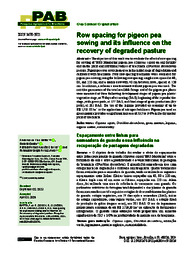Row spacing for pigeon pea sowing and its influence on the recovery of degraded pasture.
Row spacing for pigeon pea sowing and its influence on the recovery of degraded pasture.
Author(s): MATTA, F. de P.; GODOY, R.; OLIVEIRA, P. P. A.; FERRAZ JUNIOR, R. S.
Summary: ABSTRACT - The objective of this work was to evaluate the effect of row spacing for sowing of 'BRS Mandarim' pigeon pea (Cajanus cajan) on soil fertility and on the yield and nutritional values of brachiaria (Urochloa decumbens) pasture. Pigeon pea was sown in an area in the initial stage of degradation and cultivated with brachiaria. Four row-spacing treatments were evaluated for pigeon pea sowing, using the following row spacing: single rows spaced at 40, 80, and 120 cm; and a double-row with 40 cm between rows, spaced at 120 cm. In addition, a reference area treatment without pigeon pea was used. The nutritive parameters of the total available forage and of the pigeon pea plants were measured at three following development stages of pigeon pea plants: vegetative stage, at 79 days after sowing (DAS); beginning of the reproductive stage, with green pods, at 157 DAS; and final stage of grain production (dry pods), at 281 DAS. The use of the legume provided an economy of up to R$ 1,716.30 ha-¹ in the application of nitrogen fertilizers. Pigeon pea used as green manure provides a significant increase of 53.5 to 140% in the dry matter yield of brachiaria. RESUMO - O objetivo deste trabalho foi avaliar o efeito do espaçamento entre linhas para plantio de guandu (Cajanus cajan) 'BRS Mandarim' sobre a fertilidade do solo e sobre a produtividade e o valor nutricional de pastagem de braquiária (Urochloa decumbens). O guandu foi semeado em área com estágio inicial de degradação e cultivada com braquiária. Quatro tratamentos foram avaliados para a semeadura de guandu, tendo-se utilizado os seguintes espaçamentos entre linhas: fileiras únicas espaçadas em 40, 80 e 120 cm; e fileira dupla com 40 cm entre as fileiras, espaçadas em 120 cm. Além disso, foi utilizada uma área de referência de tratamento sem guandu. Os parâmetros nutritivos da forragem total disponível e das plantas de guandu foram mensurados nos três seguintes estágios de desenvolvimento das plantas de guandu: estágio vegetativo, aos 79 dias após a semeadura (DAS); início do estágio reprodutivo, com vagens verdes, aos 157 DAS; e estágio final de produção de grãos (vagens secas), aos 281 DAS. O uso da leguminosa proporcionou economia de até R$ 1.716,30 ha-¹ na aplicação de fertilizantes nitrogenados. O guandu como adubação verde proporciona um aumento significativo de 53,5 a 140% na produtividade de matéria seca da braquiária.
Publication year: 2024
Types of publication: Journal article
Observation
Some of Embrapa's publications are published as ePub files. To read them, use or download one of the following free software options to your computer or mobile device. Android: Google Play Books; IOS: iBooks; Windows and Linux: Calibre.
Access other publications
Access the Agricultural Research Database (BDPA) to consult Embrapa's full library collection and records.
Visit Embrapa Bookstore to purchase books and other publications sold by Embrapa.

